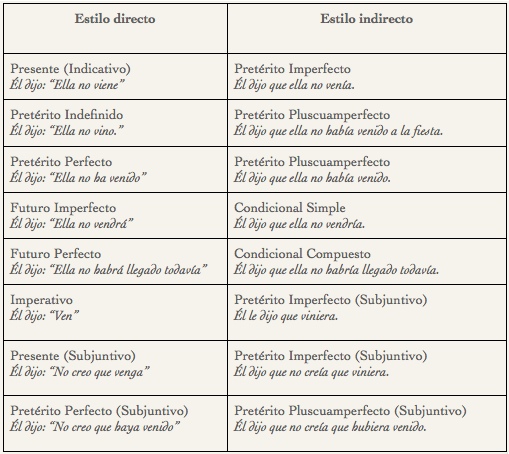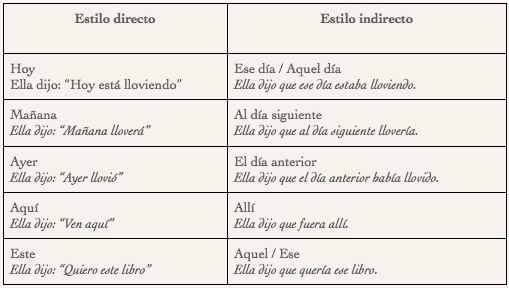We use the reported speech when we want to say what other people say, think or believe.
There are two ways of report this information:
- Direct speech: when we transmit the original message word for word. We introduce the information with an introductory verb followed by inverted commas.
Example:
The president said: “Yes we can.”
El presidente dijo: “Sí, podemos.”
- Indirect speech: when we transmit the original message with our own words. We introduce the information with an introductory verb followed by “que” (‘that’).
Example:
The president said that we could.
El presidente dijo que podíamos.
Indirect Speech (Reported Speech)
When we convert a direct speech message into indirect speech there are changes in three different aspects.
- The tense of the verb changes:
* The “Imperfecto de Indicativo y subjuntivo, pretérito pluscuamperfecto de indicativo y de subjuntivo, condicional simple y perfecto” doesn’t change.
2. The pronouns changes:
When we convert a sentence into reported speech the person speaking changes, so the first person changes into third, and the second changes into first.
Example:
He said: “I don’t want your book” > He said that he didn’t want my book.
Él dijo: “No quiero tu libro” > Él dijo que no quería mi libro.
Él dijo: “No quiero tu libro” > Él dijo que no quería mi libro.
3. The time and space expression changes:
Video Class in Spanish
Watch the video below to test your Spanish listening skills with this class about the reported speech in Spanish with subtitles.





Wohh just what I was searching for, thank you for putting up.
You really make it appear really easy along with your presentation but I in finding this topic to be really something that I feel I might by no means understand. It seems too complicated and very broad for me. I’m looking ahead to your subsequent submit, I will try to get the hang of it!
If anything is confusing about spanish grammar, it is converting indirect speech from direct speech. I am totally confused, but with your conversion table, i shall have a formula to help me in this daunting part of spanish grammar. Thanks
Could someone advise me on the best way to translate, ” He told me to tell you to tell your mom hello” basically I’m trying to see the best way to translate speech between 3 or more people.
Here you have my answer: “Él me dijo que te dijera que digas Hola a tu madre” o “Él me dijo que te diga que digas hola a tu madre”
Very nice indeed. Now I can back up in clear print what I sometimes try to explain to people. There is, however, one thing I do not understand. There is an asterisk just under the first table which lists certain tenses which do not change. What does this mean? Do you have a couple of examples? Muchas gracias, Melita
Hi Melita,
That means that the tense doesn’t change when we transform it into reported speech, we keep the same tense that we have in the Direct Speech.
Hola María, In the table for preterite, the examples for last two forms are incorrect. Preterito Imperfecto (Subjuntivo) of creer is creyeron and not creía. Please let me know
The examples are: El dijo: “No creo que venga” — El dijo que no creía que viniera. — El imperfecto de subjuntivo is only for the verb after “que”, so viniera. Creía goes in imperfecto indicativo. Same with the other examples.
This page really helped me through some tough times. Thank you professor for everything you do.
Really happy to read this David!